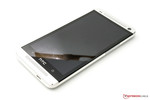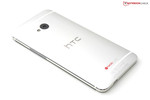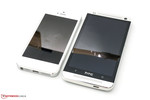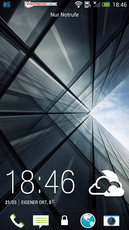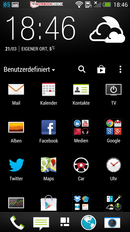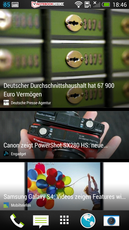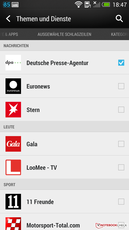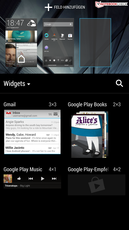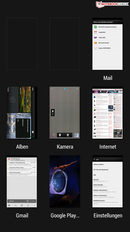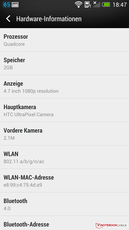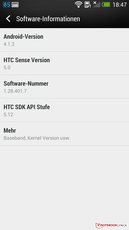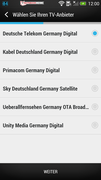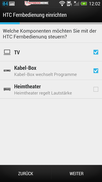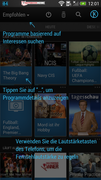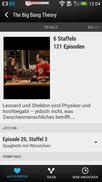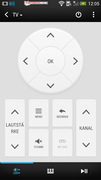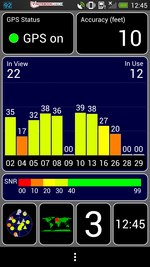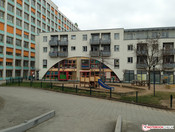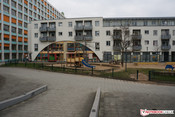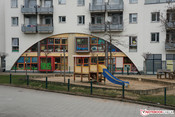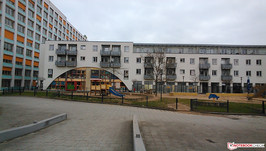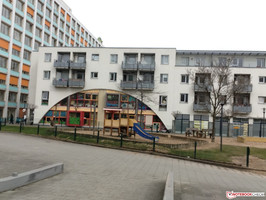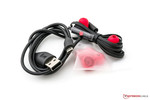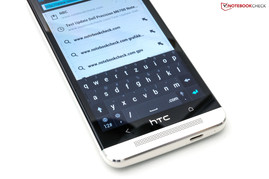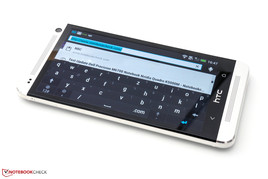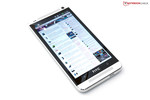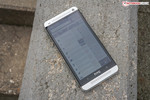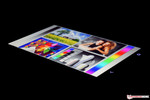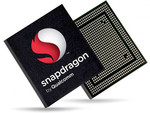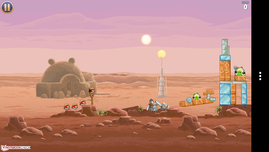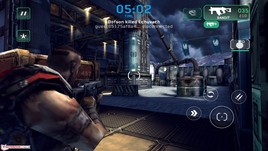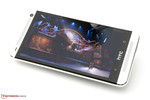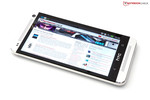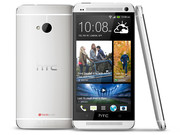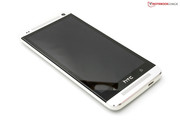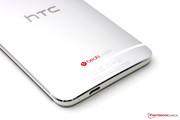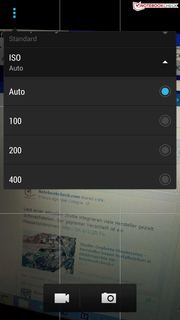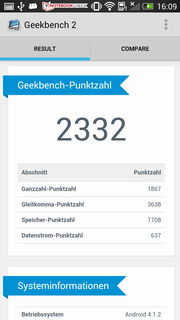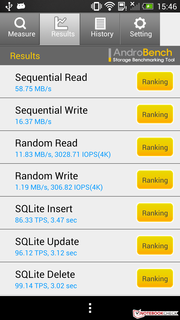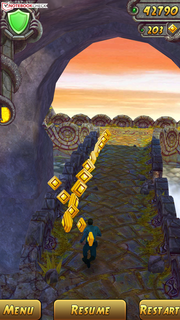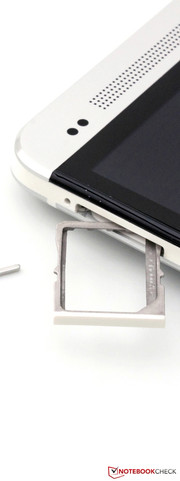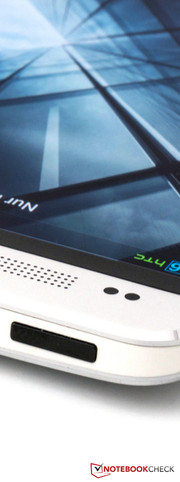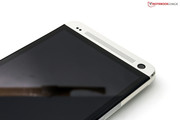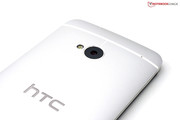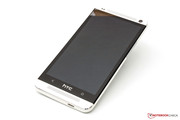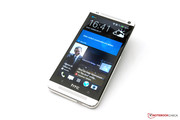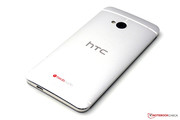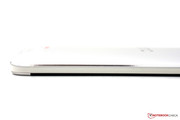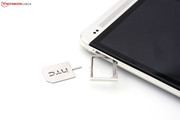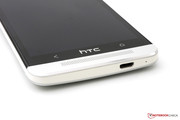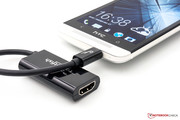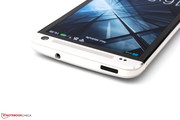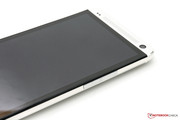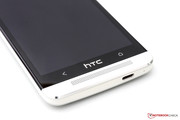Review HTC One Smartphone

For the original German review, see here.
After Sony the Taiwanese company HTC is the second manufacturer that sells its latest high-end smartphone. They have done everything right with the presentation of the HTC One in New York City. One week before the Mobile World Congress 2013 in Barcelona the smartphone created a big media interest ahead of numerous announcements. At the MWC 2013 in the end of February we had a closer look for the first time. The video can be found here.
According to the requirements HTC uses a high-quality case made of aluminum. Depending on your taste it is available in Glacial Silver or Stealth Black. Under the hood is the new Qualcomm Snapdragon 600 System-on-a-Chip (SoC) with four cores and a clock of 1.7 GHz. Other features are the 4.7-inch display with a native resolution of 1080x1920 pixels (1080p, Full HD), 2 GB memory, 32 GB storage, stereo speakers, latest wireless technologies including LTE support as well as Google Android 4.1 (Jelly Bean) with a modified HTC Sense 5 user interface.
The recommended retail price (RRP) of 679 Euros (~$877) also confirms the position in the premium segment. In this review we determine the strengths and weaknesses and make comparisons to competitive products. Important names are Apple iPhone 5, Google Nexus 4, Samsung Galaxy S4 (GT-I9505), Sony Xperia Z and the former HTC flagship device One X+.
Case
After unboxing we are welcomed by a very good looking smartphone with an aluminum case. The chassis of the HTC One consists of two aluminum parts for the front and the back, which are milled from an aluminum block. The connection of the two parts is enabled by the so-called Zero-Gap technology. Plastic is inserted between the parts and is then cut out. This results in an almost burr-free case without gaps. Accordingly, the build quality is excellent. The stability leaves nothing to be desired too. However, due to the closed construction the HTC One only gets one out of ten points in the iFixit Teardown.
The haptics are of course an important topic. The cool aluminum surfaces leave a pleasant impression. The editor also likes the rounded back. It is very comfortable in the hand. The camera at the back is flush with the case. The sticking out module is a criticism of the HTC One X or HTC One X+ respectively. Compared to the oval back the front is flat. The display is protected by durable Corning Gorilla Glass 2. Depending on the taste HTC sells the smartphone either in silver (Glacial Silver) or black (Stealth Black), but we cannot make the decision for you. A direct comparison in a store is the easiest way to choose the right model.
Now we get to the hard facts. With a size of 68.2 x 137.4 x 9.3 millimeters (width x height x depth) the HTC One weighs exactly 143 grams. With these values it is slightly thicker and heavier than the HTC One X+ with a thickness of 8.9 millimeters and a weight of 135 grams. The Samsung Galaxy S4 with its plastic case is lighter with 130 grams and also a bit thinner (7.9 millimeters). The compact iPhone 5 does not have to hide in terms of thickness and weight. With a continuous height of 7.7 millimeters the 4-inch smartphone from Cupertino only weighs 112 grams.
Connectivity
The product page of HTC lists two models with 32 or 64 GB internal storage respectively. After the first setup of the smartphone via assistant the user can use 25.3 GB; this represents a net capacity of 79%. HTC refers to a smaller capacity due to the necessary software. The storage extension via memory card is not possible in the case of the HTC One; we would have liked a card reader. Alternatively you can use 25 GB Dropbox storage in the cloud, which is free for two years.
The sides of the HTC One only offer limited ports. Next to a volume rocker and a 3.5 mm stereo jack there is a Micro-USB 2.0 port at the bottom, which supports the Mobile High-Definition Link (MHL). With an inexpensive adaptor for around 10 Euros (~$12) content can be transferred to a TV or PC monitor via HDMI. A special feature is hidden inside the power button. It is also an infrared port. A handy feature that can also be found on board the Samsung Galaxy S4. Sony currently only integrates such a component in the Xperia ZL.
Software
Simultaneously to the HTC One the company also officially announced the user interface Sense 5. In case of our review unit it is based on Google Android 4.1 (Jelly Bean). We see certain visual similarities to former versions of the launcher. Besides old and improved features HTC also presented new functions. Now you can create folders in the menu, for example. The lock screen shows location-based services and several shortcuts next to the time. After unlocking we can see the first innovation:
HTC BlinkFeed
This is a nice newsreader that refreshes automatically and should provide quick information on the go. Next to some highlighted channels we also find departments in the setting, which can be added or removed with a single click. Furthermore BlinkFeed enables the integration of social networks like Facebook, Twitter, LinkedIn or other applications. This also includes your own calendar, for example.
The picture tiles usually contain the complete articles, which can be consumed without any detours. A nice feature for a line in the post office or a train ride; we got used to it pretty quickly. However, RSS-Feeds cannot be integrated manually at the moment; this feature should be supported in a later version. BlinkFeed is always active in the background to keep the articles up to date all the time. The data volume should not be very high. Users with limited data plans can switch to WLAN refresh only. The Home button can be assigned with another function in the system settings if you do not like this feature.
HTC Sense TV
This is the name of the tool for the integrated infrared port; an application that combines the TV program and remote for multiple devices. Prior to use you have to select your zip code and provider. After that the application shows the TV program, information about shows and their runtimes. You can also create reminders; a notification appears on the One shortly before the show. During setup the smartphone continuously transmits a signal and asks for a successful connection. Only with confirmation will the smartphone accept the specific codes. During use of Sense TV the volume of the device can be adjusted with the volume rocker of the smartphone. The use of multiple devices for one function can be configured very easily. The application convinced us after a few minutes.
HTC Zoe
Zoe is a special shooting mode of the camera. Up to seven pictures are taken each second, which can be selected afterwards very easily. The recording starts one second before the actual triggering. This is very useful with fast movements; you will almost certainly get one good picture. Zoe recordings are grouped in the gallery based on location and date. Besides numerous pictures Zoe also creates small videos, which are automatically combined to a Zoe Highlight by the smartphone. These videos are between 30 and 32 seconds long and can easily be adjusted. At the beginning you can choose between six different themes (picture and sound effects). You cannot use your own background music at the moment.
Communication & GPS
You get the full package of communication equipment. Local wireless networks can be used with 2.4 or 5 GHz and the WLAN standards IEEE 802.11a/ac/b/g/n. The new standard (802.11ac) transmits with up to 1,300 Mbit/s. For comparison: The currently popular n-standard only provides up to 450 Mbit/s. However, to use the latest technology you also need a router that supports it. Data transfer between devices is handled via Bluetooth 4.0.
NFC (Near Field Communication) is the next short range wireless technology on board. To test it, HTC put two NFC-tags in the box, which can be programed with according applications. You can, for instance, allocate an address with the tag. Contact with the smartphone then starts the navigation to the address. Payment via NFC is still at the very beginning in some countries.
Needless to say, you can also use the internet on the road. The fastest solution is LTE (Long Term Evolution). The frequencies 800, 1,800 and 2,600 MHz support download speeds of up to 100 Mbit/s and upload speed up to 50 Mbit/s. Prerequisite is a data plan with LTE option. Thanks to HSPA/WCDMA support users without this expensive option can use up to 42 Mbit/s (HSPA+). In this case the frequencies 850, 900, 1,900 and 2,100 are being used. The actual speed depends on the provider and the current reception at your location.
We checked the reception quality with the application GPS Test. Outdoors the initial location takes only a couple of seconds. The accuracy is also good in this scenario. As expected, the performance is reduced in a stairwell, basement or garage. But all in all the performance is good, which pays off in daily situations. Examples are navigation applications and location based services like Facebook Places, Foursquare or even the geographical sorting of Zoe-recordings in the gallery of HTC Sense 5.
Telephone Function
The telephone function of Android 4.1 (Jelly Bean) does not hold any big surprises. Visually the application is different because of the modified user interface. The use of the application including tabs in the upper area is self-explanatory. The smartphone itself supports the four main GSM frequencies 850, 900, 1,800 and 1,900 MHz, so the One can be used in almost every network worldwide. A country-specific Micro-SIM (prepaid) or an international option are usually advisable. You can get more information on this topic from your provider.
Cameras & Multimedia
HTC resists the megapixel race and integrates a main camera at the back with a resolution of 4 megapixels (2688x1520 pixels). It is a so-called UltraPixel camera with a BSI sensor, the HTC ImageChip 2 and a 28 millimeter lens with an aperture ratio of f2.0 as its main components. Compared to a camera with 13 megapixels the individual pixels are larger, so more light can be caught. However, the pictures do not qualify for large posters, but the smartphone camera is mostly intended for snapshots anyway. We do not recommend the use of the optical zoom; the picture quality quickly decreases because the pixels are only scaled up.
For daily use the main camera of the HTC One makes acceptable pictures but we are not blown away. Considering the strong advertisement by HTC we expected a bit more. For comparison we included pictures of the Apple iPhone 5 and the Sony NEX-5R system-camera. After multiple reports on the internet HTC confirmed problems with the software; the manual ISO setting did not work properly. The maximum value was just raised but it did not force the camera to expose with a higher ISO value. A software update was not available at the time of this review. In combination with Zoe a solid performance, you should not expect the performance of a reflex camera anyway. A slight noise in dark environments cannot be completely avoided even with larger pixels.
The front-facing camera is intended for video chats. The module has a resolution of 2.1 megapixels and an 88° wide-angle lens. The image quality is also okay for its purpose. Besides that the two cameras of the HTC One can record videos in Full HD (1920x1080 pixels, 1080p). With such a high resolution 30 fps is the maximum. Furthermore the settings are pretty extensive. The possibility to use filters during operation is new; this applies to pictures as well as video recordings. Combined with Zoe you do not really need additional applications like Instagram and Co.
The HTC One can handle all common audio and video formats, even high resolution Matroska Media Container video files (.mkv) can be watched. You should try that on this display but you should also know that DTS audio does not work. Alternative applications can handle it but in this case there are delays in the picture from time to time. However, there are numerous converters for DTS audio files on the internet. Recordings of audio and video material are saved in the .amr or .mp4 format respectively.
Accessories
Inside the box we find a slightly higher standard. Next to the device itself HTC adds an in-ear headset with different caps. It is not provided by Beats Audio but still better compared to a very simple solution. Furthermore the box contains documentations, a SIM-tool and a USB cable. Our review unit from the UK does not have a modular USB-PSU; in some countries however, the smartphone is shipped with this accessory.
Optional products can be found in the HTC shop. For example an external battery with USB port and a capacity of 3,000 mAh for 55 Euros (~$71), a black flipping case (HC V841) with red interior for 30 Euros (~$38), a protective case (HC C840) for 20 Euros (~$25), display protection (11 Euros, ~$14) and a car mounting kit (CAR D160, 50 Euros, ~$64). Except for the universal additional battery the optional accessories are fortunately in stock. A price comparison is recommended; dealers often sell the products for a much lower price.
Warranty
The HTC One comes with a warranty period of 24 months. The accessories as well as the battery are covered for 12 months. HTC itself does not offer any warranty extensions.
Input Devices & Handling
The HTC One is operated via capacitive touchscreen that was visually laminated. Contacts and swipe movements on the display are executed precisely without any delays. The display has no problems with multi-touch gestures like pinch-to-zoom or tap-to-zoom either. Up to ten fingers are recognized simultaneously; in daily situations you usually only use two or three fingers at the same time.
A virtual keyboard can be used for typing, it automatically appears if necessary. Visually it is no different to the keyboard of the HTC One X+, but the input device was slightly modified in HTC Sense 5. The annoying arrow keys are now deactivated out of the box and the settings are a bit more extensive. The input via swipe movement can also be activated there. A nice feature that should be tried. It is very positive that the keyboard only uses a small part of the display area in the profile mode; the ergonomics are not reduced.
There is also something new with the Android operating controls beneath the display. Instead of three there are only two touch-sensitive buttons: The Back-button and the Home-button. The App-Switcher (multitasking) is realized with a double tap on the Home-button in the case of the HTC One. The HTC logo is without any function ex-works. According to XDA-Developers the use as a third button is possible. It remains to be seen if HTC will offer an official update or if this feature has to be activated with a custom ROM.
Display
Smartphone displays are getting bigger and bigger. Samsung and Sony both use 5-inch screens. HTC sticks with the 4.7-inch format. Compared to the One X+ the display of the HTC One has a finer resolution. With the same size the Sharp display now displays 1080x1920 pixels in profile mode. In the landscape mode this of course complies with the Full HD standard (1080p, 1920x1080 pixels). The glossy screen is a liquid crystal display called Super Liquid Crystal Display 3 - or in short SLCD3. The formerly mentioned values result in a pixel density of 468 ppi (pixels per inch). The picture is razor-sharp. For the human eye the comparison with the 326 ppi of the Apple iPhone 5 is very difficult.
With the tool X-Rite i1Pro 2 we took a closer look at the display of the One. In the first step the luminance had to prove itself. We determine the value at nine different spots; this results in an average brightness of 489 cd/m². The Sony Xperia Z falls behind with "only" 428 cd/m², the Apple iPhone 5 is on the same level. The cheaper Google Nexus 4 is not the brightest star in the smartphone sky with 275 cd/m². Another advantage of the SLCD3 is the consistent brightness distribution (90%); the fluctuations are not visible during daily use.
| |||||||||||||||||||||||||
Brightness Distribution: 90 %
Center on Battery: 487 cd/m²
Contrast: 2117:1 (Black: 0.23 cd/m²)
The other measurements also comply with the premium claim. The black value of 0.23 cd/m² is very low. The result is a rich representation of black, which favors the playback of movies and pictures. Combined with the high display brightness this leads to an extremely high contrast ratio of 2,117:1. From the formerly mentioned devices the Xperia Z is by far the worst with 0.98 cd/m², followed by the iPhone 5 with an acceptable value of 0.48 cd/m². The Google Nexus 4 leaves a positive impression with 0.24 cd/m² and a contrast of 1,179:1.
In addition to these measurements we also checked the color management, saturation and the grayscale presentation. The RGB-balance shows a positive deviation of blue and a slightly weak pronounced red; overall the picture is a bit too cool. This is however not a big criticism since the deviations are very small. There are no adjustment possibilities in the settings. Latest Samsung smartphones offer such a feature in the Google Android settings. Subjectively the presentation and the image sharpness leave a positive impression.
The HTC One makes a good impression outdoors. Despite the glossy surface the smartphone can be used without problems. Reasons for that are the high brightness, the good black value and the excellent contrast ratio. We deactivated the Auto Brightness in this scenario. With backlight conditions the auto setting sometimes does not assess the ambient light correctly but this is not a device-specific problem. An optimal solution would be a matte display protection. With serious interest you should not take the cheapest model; they tend to reduce the sharpness of the picture.
The Sharp SLCD3 has no problems with the viewing angle stability. Even with views from the side we cannot determine any changes. The visibility of content is still good, colors remain stable and there is no apparent brightness reduction; here the high-quality display pays off.
Performance
The heart of the HTC One is the new Qualcomm Snapdragon 600 SoC. This chip is based on the specifically developed Krait-300 architecture; it has four cores with a performance of 1.7 GHz each and also accommodates an enhanced version of the Adreno 320 Graphics with a higher clock. It is manufactured in a 28 nm process. Compared to the currently popular Snapdragon S4 SoCs the architecture was improved. The performance of Cortex-A15 cores is not reached; however, the power consumption is lower.
The integrated decoder of the Snapdragon 600 is able to handle Full HD material with up to 30 fps and 3D pictures with up to 20 megapixels without problems. Besides these features the chip also has space for a wireless module, which supports Bluetooth 4.0 and the WLAN standards 802.11a/ac/b/g/n. Further features are 2 GB LPDDR-2 memory and 32 GB integrated storage. Interestingly HTC does not use modern LPDDR-3 RAM despite the support of the SoC. It can be found inside the Samsung Galaxy S4, for example.
We start our extensive benchmark suite with the local system benchmarks. The first highlight is the AnTuTu benchmark (version 3). In this test the HTC One reaches 23,500 points; the result is sufficient for a clear lead. The Sony Xperia Z with Snapdragon S4 Pro SoC falls behind by 39% with 14,244 points. One X+ as well as Google Nexus 4 are a bit faster than the Sony smartphone but the difference to the HTC One is still obvious with 31 and 25%. In the NenaMark 2 the competitors are closer together. With 60.4 fps our review unit just takes the lead.
The OS-independent Geekbench 2 shows a similar picture, although the differences are bigger again. The overall rating of 2,332 points is sufficient for the lead ahead of the Google Nexus 4 with 2,054 points (difference: 12%) and the Sony Xperia Z with 1,918 points (difference: 18%). Another top result is the Multi-Thread calculation of Linpack; with 733 MFLOPS it is by far the best result in our ranking. Only in Basemark ES 2.0 the HTC One is beaten by the Google Nexus 4. 41 fps is only enough for the second place. The Google-Smartphone is about 30% better in this test with around 54 fps.
| AnTuTu v3 - Total Score (sort by value) | |
| HTC One | |
| Sony Xperia Z | |
| HTC One X+ | |
| Samsung Galaxy S3 | |
| Google Nexus 4 | |
| NenaMark2 - --- (sort by value) | |
| HTC One | |
| Sony Xperia Z | |
| HTC One X+ | |
| Samsung Galaxy S3 | |
| Google Nexus 4 | |
| Geekbench 2 - 32 Bit - Total Score (sort by value) | |
| HTC One | |
| Sony Xperia Z | |
| HTC One X+ | |
| Samsung Galaxy S3 | |
| Google Nexus 4 | |
| Apple iPhone 5 | |
| Basemark ES 2.0 - Taiji Free (sort by value) | |
| HTC One | |
| Sony Xperia Z | |
| HTC One X+ | |
| Samsung Galaxy S3 | |
| Google Nexus 4 | |
| Linpack Android / IOS - Multi Thread (sort by value) | |
| HTC One | |
| Sony Xperia Z | |
| HTC One X+ | |
| Samsung Galaxy S3 | |
| Google Nexus 4 | |
| Apple iPhone 5 | |
Now we get to the browser based benchmarks; we ran them with the app from HTC. Alternatives like Google Chrome can also be installed without problems. In the Futuremark Peacekeeper the HTC One gets a rating of 683 points; clearly ahead of other Android smartphones and Windows Phone 8 (WP8) devices. The 43% deficit of the Sony Xperia Z (Google Chrome) is surprising; Samsung Galaxy S3 or HTC One X+ cannot be beaten that easily. However, the winner in this test is the Apple iPhone 5 with the mobile version of Safari. The device gets 863 points and manages an advantage of 26%. Browsermark 2.0 by Rightware shows similar results.
In the Google-V8 Benchmark the HTC browser delivers a good result in the upper third of our database. The overall result of 1,899 points is not enough for the top position in our ranking. The HTC One X+ is better with 2,136 points (difference: 12%). Smartphones with WP8 and Internet Explorer cannot convince in this test with around 800 points. Finally we have a look at the JavaScript benchmark Sunspider 0.9.1. In this test the lowest result wins. 1138 milliseconds indicates a good performance but in this scenario it is beaten by the HTC Windows Phone 8X with only 896 milliseconds (difference: 21%). The Apple iPhone 5 also manages a comfortable lead of 18% (935.4 milliseconds).
| Peacekeeper - --- (sort by value) | |
| HTC One | |
| Sony Xperia Z | |
| HTC One X+ | |
| Samsung Galaxy S3 | |
| Google Nexus 4 | |
| Apple iPhone 5 | |
| Samsung ATIV S | |
| Browsermark - --- (sort by value) | |
| HTC One | |
| Sony Xperia Z | |
| HTC One X+ | |
| Samsung Galaxy S3 | |
| Google Nexus 4 | |
| Apple iPhone 5 | |
| Nokia Lumia 920 | |
| Samsung ATIV S | |
| Google V8 Ver. 7 - Google V8 Ver. 7 Score (sort by value) | |
| HTC One | |
| Sony Xperia Z | |
| HTC One X+ | |
| Samsung Galaxy S3 | |
| Google Nexus 4 | |
| Apple iPhone 5 | |
| Nokia Lumia 920 | |
| Samsung ATIV S | |
| HTC Windows Phone 8X | |
| Sunspider - 0.9.1 Total Score (sort by value) | |
| HTC One | |
| Sony Xperia Z | |
| HTC One X+ | |
| Samsung Galaxy S3 | |
| Google Nexus 4 | |
| Apple iPhone 5 | |
| Nokia Lumia 920 | |
| Samsung ATIV S | |
| HTC Windows Phone 8X | |
* ... smaller is better
The integrated flash storage is an important part for the system performance. We checked the performance of the component with AndroBench 3. The HTC One leaves a good impression with sequential as well as random operations. With a maximum of 58.75 MB/s similar devices clearly fall behind. The Sony Xperia Z has to live with a deficit of 17%, the HTC One X+ has the "slowest" integrated memory in our comparison table. The smartphone reaches transfer rates of 37 MB/s during sequential writing (difference: 37%). With random 4K-operations the differences are smaller; in this case both the Sony Xperia Z and the Google Nexus 4 can convince.
| AndroBench 3-5 | |
| Random Write 4KB (sort by value) | |
| HTC One | |
| Sony Xperia Z | |
| HTC One X+ | |
| Samsung Galaxy S3 | |
| Google Nexus 4 | |
| Random Read 4KB (sort by value) | |
| HTC One | |
| Sony Xperia Z | |
| HTC One X+ | |
| Samsung Galaxy S3 | |
| Google Nexus 4 | |
| Sequential Write 256KB (sort by value) | |
| HTC One | |
| Sony Xperia Z | |
| HTC One X+ | |
| Samsung Galaxy S3 | |
| Google Nexus 4 | |
| Sequential Read 256KB (sort by value) | |
| HTC One | |
| Sony Xperia Z | |
| HTC One X+ | |
| Samsung Galaxy S3 | |
| Google Nexus 4 | |
Gaming
The enhanced Adreno 320 GPU of the Qualcomm Snapdragon 600 shows no weaknesses in regard to the gaming performance. The Epic Citadel benchmark is a good comparison. In the High-Performance mode the HTC One manages an average frame rate of 57.5 fps; the smartphone takes the current top position in our database. Google Nexus 4 or Sony Xperia Z with the Qualcomm Snapdragon S4 Pro are just slightly behind.
For the real-world test we downloaded several games from the Google Play Store, including simple titles like Angry Birds Star Wars or Temple Run 2 as well as more demanding 3D games. We tried Shadowgun: DeadZone and Real Racing 3; the games look good and run smoothly. Smartphone-gamers will enjoy the HTC One.
| Epic Citadel - High Performance (sort by value) | |
| HTC One | |
| Sony Xperia Z | |
| Google Nexus 4 | |
| HTC One X+ | |
| HTC One X+ | |
Voice Quality
After multiple calls with the HTC One our impression is good. The user's voice is clear and natural on the other side. The HTC One owner can also understand the caller very well, although the other phone is also a factor. The second microphone on the back for video recording and suppression of ambient noise works reliably. Even the hands-free function via speakers can convince, we also like the sound of the in-ear headset. It is a good solution to begin with; the different adaptors make sense.
Emissions
Temperature
The temperature development is very important with a device that is almost exclusively used in the hand. During idle or office tasks the case barely warms up. The aluminum does not get warm but it loses the otherwise cool haptics. At the back we measured a maximum of 30.2 °C. Everything is in the blue area - in the case of our diagram.
Under load the components produce more heat; the chassis warms up accordingly. The maximum value of 35.2 °C at the back can be felt. Subjectively the perception fluctuates between lukewarm and warm. You might even find it hot at some spots. In direct comparison to the One X+ the HTC One is clearly better.
(+) The maximum temperature on the upper side is 36.6 °C / 98 F, compared to the average of 35.2 °C / 95 F, ranging from 21.9 to 247 °C for the class Smartphone.
(+) The bottom heats up to a maximum of 35.2 °C / 95 F, compared to the average of 34 °C / 93 F
(+) In idle usage, the average temperature for the upper side is 30.3 °C / 87 F, compared to the device average of 32.9 °C / 91 F.
Speakers
A specialty of the HTC One is the stereo speakers at the front with an integrated amplifier. HTC lists them under the name "HTC Boom Sound". We are not disappointed by the big promises. After the first couple of songs it becomes evident that we found the currently best smartphone speakers. Real stereo sound in the landscape mode, quite a full sound and a convenient volume. With high-quality audio files the sound does not distort either. Bass and low tones are present but obviously not as pronounced compared to high-end peripherals.
The sound is supported by software enhancements. In the system settings we find the known equalizer setting by Beats Audio. In this context we also have to talk about the revised "Music" application. The HTC specific music player was revised with the Sense 5 user interface. The application can now visualize song lyrics. Nice features that can be activated with a symbol in the upper right corner.
Headphones, external speakers or even the own home cinema system can be connected over the 3.5 mm stereo jack, Bluetooth or the Micro-USB port. As mentioned before you need an MHL-HDMI adaptor for the USB port. The output quality is excellent.
Energy Management
Power Consumption
In addition to the enhanced performance Qualcomm also improved the efficiency of the Snapdragon 600 SoC. With activated energy-saving mode the clock is limited, which reduces the energy consumption. During idle and with minimum brightness the HTC One consumes between 0.4 and 1.1 Watts. With these values it is more frugal than the HTC One X+ with the Nvidia Tegra 3+ SoC, the Google Nexus 4 with a maximum of 1.4 Watts or the Sony Xperia Z as a negative example. With the Qualcomm Snapdragon S4 Pro this smartphone consumes up to 3.7 Watts in this scenario. Even the iPhone 5 is beaten in terms of maximum value (idle) with 1.4 Watts; the minimum consumption of 0.4 Watts is identical.
Under load the HTC One needs up to 4 Watts. Leader in this category is the Apple iPhone 5 with a maximum of 2.9 Watts. Comparable Android smartphones consume more energy; the HTC One X+ up to 4.4 Watts, the Google Nexus 4 up to 6.5 Watts or the Sony Xperia Z with up to 6.6 Watts. The energy consumption during standby or when it is switched off is inconspicuous; during standby the consumption fluctuates between 0.5 and 0.8 Watts.
The power supply on the go is handled by an integrated lithium-polymer battery with 8.74 Wh or 2,300 mAh respectively. The battery cannot be replaced; the Samsung Galaxy S4 offers this feature. The battery is also larger with 2,600 mAh. The battery of the Asus PadFone Infinity just slightly differs with 2,400 mAh.
| Off / Standby | |
| Idle | |
| Load |
|
Key:
min: | |
Battery Runtime
With the maximum runtime we get to the final measurements of this review. With minimum brightness, activated energy-saving mode and deactivated wireless modules we simulate the reading of a text document. Only after 23 hours and 51 minutes the HTC One had to be plugged in. A very good result compared to the most important competitors. The other extreme is the minimum runtime under load. With maximum brightness and activated wireless modules we run the stress test of the application Stability Test. After 2 hours and 49 minutes the full charge is gone. A similar result to other devices that usually keep up between two and three hours.
The measurement "Surfing with WLAN" is a more realistic scenario. With a standardized display brightness of 150 cd/m² a new web page is loaded every 40 seconds. The possible runtime of 10 hours and 53 minutes is also convincing. The Sony Xperia Z only works for 8 hours and 50 minutes. Only the Google Nexus 4 is worse (7 hours and 20 minutes), the HTC One X+ is on the same level. The Apple iPhone 5 scores with more than 15 hours, however, flash content cannot be displayed on this device.
Last but not least we checked the performance during Full HD video playback (1920x1080 pixels, 1080p). Thanks to the good display and the maximum brightness this is a joy. Unfortunately the joy is over after 5 hours and 27 minutes. This runtime is more than sufficient for two movies.
Verdict
The Taiwanese manufacturer is full on attack with the HTC One. Successful. The high-quality aluminum case easily keeps up with the Apple iPhone 5. In a comparison the One does offer the more modern hardware, starting with the high resolution 4.7-inch display that convinces during everyday use and with the measured values. Under the hood is the new Qualcomm Snapdragon 600 SoC combined with all the latest wireless technologies, 32 GB internal storage and 2 GB memory. Unfortunately it is only an LPDDR-2 module. The biggest drawbacks are the non-removable battery and the missing card reader. Certainly an advantage of the Samsung Galaxy S4, which will be available in April.
In addition to the convincing hardware HTC also improved the software. The user interface HTC Sense 5 with features like BlinkFeed, the shooting mode Zoe or revised applications leave a good impression. Unfortunately, the camera application currently still has a problem with the ISO setting but this is no problem for the common user. We would have expected a bit more in regard to the performance of the UltraPixel camera.
We were really convinced by the stereo speakers of the HTC One. The location at the front enables real stereo sound, which also sounds good. Combined with the good Full HD display video playback is great. Finally the smartphone also offers decent battery runtimes. In the realistic scenario "Surfing with WLAN" runtimes of around eleven hours are possible.
All in all, a successful smartphone that raises the bar quite a bit. We are looking forward to the comparison with the upcoming high-end Android devices Samsung Galaxy S4 and Asus PadFone Infinity. Considering the development Apple is now in a tight spot. A slightly enhanced iPhone 5 would be the right choice. For the time being the HTC One takes the top position within the mentioned smartphones.




